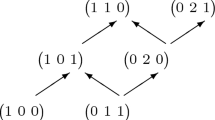Abstract
Some real-world examples of simple games, like the procedure to amend the Canadian Constitution, are complete simple games with minimum. Using characteristic invariants for this class of games, we study different types of solution concepts. For an arbitrary number of players we get the nucleolus by means of a determinate compatible system of equations, characterize the maximality of the kernel and give a method to calculate semivalues. Several applications are found at the end of the paper.
Similar content being viewed by others
References
R.J. Aumann, B. Peleg and P. Rabinowitz, A method for computing the kernel of n-person games, Mathematics of Computation 19(1965)531–551.
R.J. Aumann, P. Rabinowitz and D. Schmeidler, Kernels of superadditive simple 5-person games, RM 18, Research Program in Game Theory and Mathematical Economics, Dept. of Mathematics, The Hebrew University of Jerusalem, 1966.
F. Carreras and J. Freixas, Complete simple games, Math. Social Sciences 32(1996)139–155.
M. Davis and M. Maschler, The kernel of a cooperative game, Nav. Res. Log. Quart. 12(1965)223–259.
P. Dubey, A. Neyman and R.J. Weber, Value theory without efficiency, Math. of Oper. Res. 6(1981)122–128.
C.C. Elgot, Truth functions realizable by single threshold organs, in: AIEE Conference Paper, 1960, pp. 60–1311.
J.R. Isbell, On the enumeration of majority games, Math. Tables Aids Comput. 13(1959)21–28.
A. Kopelowitz, Computation of the kernels of simple games and the nucleolus of n-person games, RM 31, Research Program in Game Theory and Mathematical Economics, The Hebrew University of Jerusalem, 1967.
M. Maschler and B. Peleg, A characterization, existence proof and dimension bounds for the kernel of a game, Pacific J. of Math. 18(1966)289–328.
M. Maschler, B. Peleg and L.S. Shapley, Geometric properties of the kernel, nucleolus and related concepts, Math. of Oper. Res. 4(1979)303–338.
G. Owen, A note on the nucleolus, International Journal of Game Theory 3(1974)101–103.
B. Peleg, J. Rosenmüller and P. Sudhölter, The Kernel of Homogeneous Games with Steps, Essays in Honor of M. Maschler, 1995, pp. 163–192.
J.A.M. Potters and S.H. Tijs, The nucleolus of matrix games and other nucleoli, Math. of Oper. Res. 17(1992)164–174.
D. Schmeidler, The nucleolus of a characteristic function game, SIAM J. of Appl. Math. 17(1969)1163–1170.
A.I. Sobolev, A characterization of optimality principles in cooperative games by functional equations, Math. Meth. in the Soc. Scien. 6(1975)94–151.
A. Taylor, Mathematics and Politics, Springer, New York, 1995.
A. Taylor and W. Zwicker, A characterization of weighted voting, in: Proc. of the Amer. Math. Soc. 115, 1992, pp. 1089–1094.
A. Taylor and W. Zwicker, Simple Games: Desirability Relations, Trading and Pseudoweightings, book manuscript, forthcoming.
Rights and permissions
About this article
Cite this article
Freixas, J., Puente, M. Complete games with minimum. Annals of Operations Research 84, 97–109 (1998). https://doi.org/10.1023/A:1018905407647
Issue Date:
DOI: https://doi.org/10.1023/A:1018905407647



